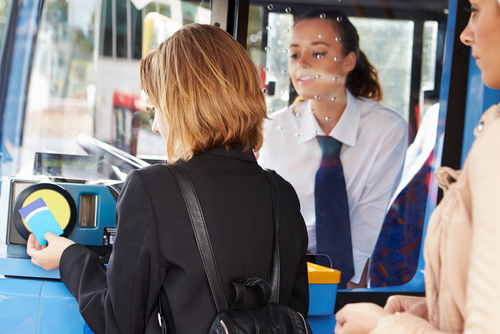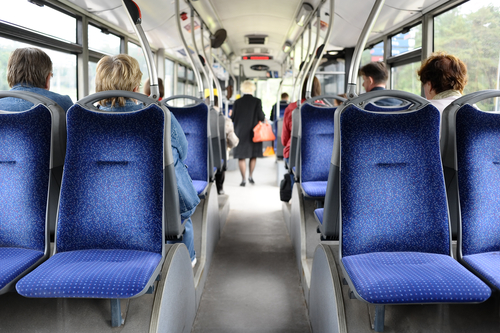Take the Bus
If you are in an area with convenient bus service, taking the bus can’t be beat. It is generally one of the lowest cost forms of transportation - a benefit to any budget. It can also significantly lower your climate emissions, by 80% or more, over driving a car.
Your Impact
Action Steps & Tips
Introduction
 Cars are convenient. However, depending on where you live, you may find yourself stuck in traffic and wondering if there is a better way to get around. Solution? Try the bus.
Cars are convenient. However, depending on where you live, you may find yourself stuck in traffic and wondering if there is a better way to get around. Solution? Try the bus.
Good bus service does not exist everywhere, but this is changing. More and more companies are offering bus service to employees for commuting and many cities are looking to expand bus service as part of sustainability plans.
If you have good bus service in your area, the bus is a great option that can save you time and money, while also reducing road congestion, carbon emissions, and air pollution. According to AAA, the cost of driving a car is $.65/mile or more for the average driver. Riding the bus typically costs around $1-3 per trip, or generally $.35 - $.50/mile. That’s a big savings. Even better, you can reclaim some of your commute time by reading or working while in transit—something you can’t do when you are behind the wheel.
Check out the bus service options in your community and the tips below and consider taking the bus!
1Check schedules and plan ahead
Check out the bus routes. The first step—check out the bus routes and find which one will get you where you need to go. There may be only one bus service (company) in your area, or there may be multiple services. You can generally find the bus schedule online or at any bus stop. The information may also be available on a smartphone app, including alerts for delays and real-time arrival times.
Try a trip planning app. If available, use the trip planning feature on your local bus service website or using Google Maps. Simply put in your starting location and destination and get instructions for what buses to take including any transfers. If using Google Maps, select the Transit option instead of the private car. When planning your trip, check for both pickup and destination times to make sure you will arrive when needed.
Walk or bike to the bus stop. If the bus stop is close, consider walking. If it’s not within walking distance, consider biking to the stop. Most buses accommodate passengers with bikes, often with a bike rack. If you are unsure of how to use the bike rack, look at the bus company website for information or ask the bus driver for help loading your bike the first time. Most buses also accommodate disabled riders and wheelchairs. Check with the bus company for more information on how to use this service.
Check on the fare. Before you head to the bus stop, check on the fares. If you are only taking the bus occasionally, you will probably want to pay for each ride. In this case, make sure you have exact change because bus drivers typically cannot make change for you.
If you plan to ride the bus often, getting a bus pass can save a lot of money. This is also more convenient than scrambling for exact change. Many companies will pay for bus passes for employees, and many bus passes also give discounts for the elderly or disabled. Check your pass for other options—it might work with other local public transport systems as well.
2Go for a ride
Taking the bus is easy. Here are a few tips for your trip:
Arrive early. Try to arrive a few minutes early at the bus stop. It is no fun chasing after the bus to get it to stop!
Check the sign. Before you board the bus, check to make sure you are getting on the right bus. Buses have digital signs on the front or side indicating the destination and the route number. Once you are onboard, keep watch to make sure you know where you are and don’t miss your stop. If you’re not sure, don’t be afraid to ask the bus driver or other passengers for help identifying your stop.
Telling the driver when to stop. Usually, there is a cord to pull or button to push to request a stop. Push this early enough to give the driver time to stop.
Don’t forget your stuff! Keep your belongings close to you so you don’t forget them or have them picked up by other riders. If you like to listen to music on the bus, keep one earbud in and one out so you can hear your stop announced or any directions from the bus driver.
Relax, read a book and enjoy the ride! Taking the bus has other perks—time to catch up on reading a good book, check your email or relax and listen to music. And, it makes a difference. Studies estimate that if public transportation services were canceled nationwide and people rode in private vehicles instead, urban areas would have suffered an extra 541 million hours of delay and consumed 340 million more gallons of fuel in 2005. Enjoy the ride and know you are not only saving money and time but helping to protect our future!

